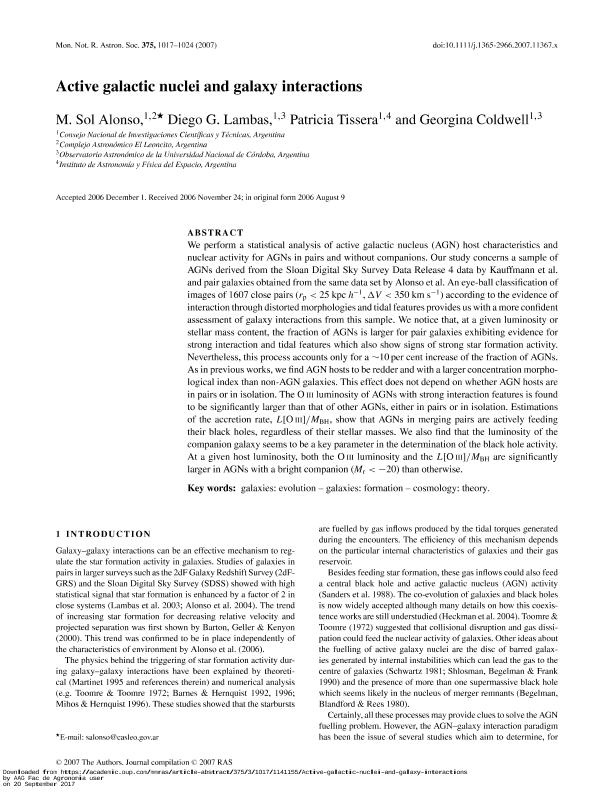Mostrar el registro sencillo del ítem
dc.contributor.author
Alonso, M. Sol
dc.contributor.author
Garcia Lambas, Diego Rodolfo

dc.contributor.author
Tissera, Patricia Beatriz

dc.contributor.author
Coldwell, Georgina
dc.date.available
2017-09-25T18:45:27Z
dc.date.issued
2007-03
dc.identifier.citation
Alonso, M. Sol; Garcia Lambas, Diego Rodolfo; Tissera, Patricia Beatriz; Coldwell, Georgina; Active Galactic Nuclei and Galaxy Interactions; Oxford University Press; Monthly Notices of the Royal Astronomical Society; 375; 3; 3-2007; 1017-1024
dc.identifier.issn
0035-8711
dc.identifier.uri
http://hdl.handle.net/11336/25053
dc.description.abstract
We perform a statistical analysis of AGN host characteristics and nuclear activity
for AGNs in pairs and without companions. Our study concerns a sample of AGNs
derived from the SDSS-DR4 data by Kauffmann et al (2003) and pair galaxies obtained from the same data set by Alonso et al. (2006). An eye-ball classification of images of 1607 close pairs (rp < 25 kpc h −1 , ∆V < 350 km s −1 ) according to the evidence of interaction through distorted morphologies and tidal features provides us with a more confident assessment of galaxy interactions from this sample. We notice that, at a given luminosity or stellar mass content, the fraction of AGNs is larger for pair galaxies exhibiting evidence for strong interaction and tidal features which also show sings of strong star formation activity. Nevertheless, this process accounts only for a ∼ 10% increase of the fraction of AGNs. As in previous works, we find AGN hosts to be redder and with a larger concentration morphological index than non-AGN galaxies. This effect does not depend whether AGN hosts are in pairs or in isolation. The OIII luminosity of AGNs with strong interaction features is found to be significantly larger than that of other AGNs, either in pairs or in isolation. Estimations of the accretion rate, L[OIII]/MBH , show that AGNs in merging pairs are actively feeding their black holes, regardless of their stellar masses. We also find that the luminosity of the companion galaxy seems to be a key parameter in the determination of the black hole activity. At a given host luminosity, both the OIII luminosity and the L[OIII]/MBH are significantly larger in AGNs with a bright companion (Mr < −20) than otherwise.
dc.format
application/pdf
dc.language.iso
eng
dc.publisher
Oxford University Press

dc.rights
info:eu-repo/semantics/openAccess
dc.rights.uri
https://creativecommons.org/licenses/by-nc-sa/2.5/ar/
dc.subject
Galaxies: Evolution
dc.subject
Galaxies: Formation
dc.subject
Cosmology: Theory
dc.subject.classification
Astronomía

dc.subject.classification
Ciencias Físicas

dc.subject.classification
CIENCIAS NATURALES Y EXACTAS

dc.title
Active Galactic Nuclei and Galaxy Interactions
dc.type
info:eu-repo/semantics/article
dc.type
info:ar-repo/semantics/artículo
dc.type
info:eu-repo/semantics/publishedVersion
dc.date.updated
2017-09-20T13:40:13Z
dc.journal.volume
375
dc.journal.number
3
dc.journal.pagination
1017-1024
dc.journal.pais
Reino Unido

dc.journal.ciudad
Londres
dc.description.fil
Fil: Alonso, M. Sol. Consejo Nacional de Investigaciones Científicas y Técnicas. Centro Científico Tecnológico Conicet - San Juan. Complejo Astronómico "el Leoncito". Universidad Nacional de Córdoba. Complejo Astronómico "el Leoncito". Universidad Nacional de la Plata. Complejo Astronómico "el Leoncito". Universidad Nacional de San Juan. Complejo Astronómico "el Leoncito"; Argentina
dc.description.fil
Fil: Garcia Lambas, Diego Rodolfo. Universidad Nacional de Cordoba. Observatorio Astronomico de Cordoba; Argentina. Consejo Nacional de Investigaciones Científicas y Técnicas; Argentina
dc.description.fil
Fil: Tissera, Patricia Beatriz. Consejo Nacional de Investigaciónes Científicas y Técnicas. Oficina de Coordinación Administrativa Ciudad Universitaria. Instituto de Astronomía y Física del Espacio. - Universidad de Buenos Aires. Facultad de Ciencias Exactas y Naturales. Instituto de Astronomía y Física del Espacio; Argentina
dc.description.fil
Fil: Coldwell, Georgina. Universidad Nacional de Cordoba. Observatorio Astronomico de Cordoba; Argentina
dc.journal.title
Monthly Notices of the Royal Astronomical Society

dc.relation.alternativeid
info:eu-repo/semantics/altIdentifier/url/http://arxiv.org/abs/astro-ph/0701192
dc.relation.alternativeid
info:eu-repo/semantics/altIdentifier/url/https://academic.oup.com/mnras/article-lookup/doi/10.1111/j.1365-2966.2007.11367.x
dc.relation.alternativeid
info:eu-repo/semantics/altIdentifier/doi/http://dx.doi.org/10.1111/j.1365-2966.2007.11367.x
Archivos asociados
